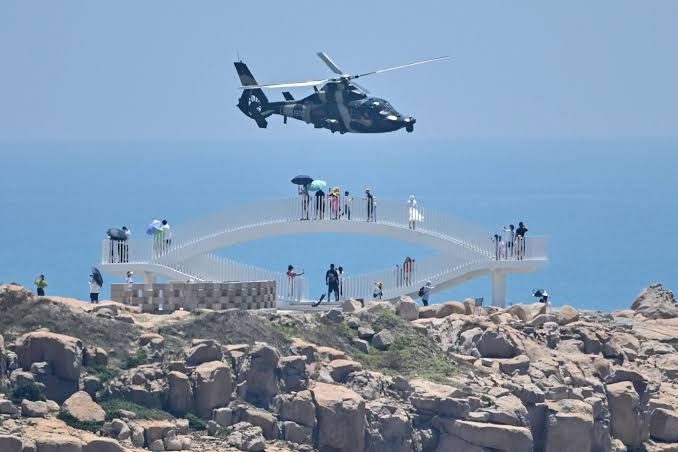China has once again raised tensions in the Taiwan Strait after launching its largest and most integrated military drills in recent years. The People’s Liberation Army (PLA) deployed warplanes, naval vessels, rocket forces, and even amphibious landing barges in exercises that Taiwan described as an unprecedented escalation aimed at testing its defenses and readiness.
The operations, branded “Strait Thunder-2025A,” showcased the scale of Beijing’s military capability and its growing readiness for high-tempo conflict scenarios. Taiwan’s Ministry of National Defense confirmed that during the two-day drills, 59 PLA warplanes and 23 navy ships were detected encircling the island. Notably, 18 aircraft crossed the median line of the Taiwan Strait, a boundary long considered an unofficial buffer that China refuses to recognize.
Record Air and Naval Activity
In early 2025, PLA activity around Taiwan reached new records. In January alone, aircraft incursions across the median line surged to 248, compared with just 72 in the same month last year. Naval patrols followed a similar pattern, with nearly 200 warships observed near Taiwan’s waters, up from 142 the year before.
These operations also included repeated entries into Taiwan’s Air Defense Identification Zone (ADIZ), forcing the island’s air force to scramble jets almost daily. Analysts noted that such “normalized” incursions are intended to stretch Taiwan’s resources while simultaneously training PLA forces under realistic combat conditions.
Advancing Operational Capabilities
Beyond the numbers, the PLA demonstrated advanced operational integration. The aircraft carrier Shandong sailed as close as 24 nautical miles from Taiwan’s coast, conducting simulated strikes and enforcing area control maneuvers. According to military analysts, these drills mirror a structured three-phase assault strategy involving missile barrages, air dominance operations, and potential amphibious landings.
China has also tested Shuiqiao-class landing barges, new amphibious causeway vessels designed to establish temporary piers for rapid landings. This capability would allow PLA troops to bypass Taiwan’s heavily fortified beaches and open alternative landing routes. The addition of such equipment signals Beijing’s growing capacity to conduct a large-scale blockade or invasion if ordered.
Strategic Messaging and Regional Reactions
For Beijing, these drills serve both practical and political purposes. On one hand, they enhance PLA readiness and expose Taiwan’s vulnerabilities. On the other, they send a strong message to both Taipei and Washington that China is prepared to act decisively if its sovereignty claims are challenged.
Taiwan responded with its own Han Kuang drills, simulating counter-amphibious warfare and urban defense scenarios. The United States, Japan, and Australia closely monitored the exercises, with Washington reiterating its commitment to Taiwan’s defense under the Taiwan Relations Act. Meanwhile, Tokyo expressed deep concern, warning that escalating PLA activity threatens the stability of the entire Asia-Pacific region.
Implications for Global Security
The Taiwan Strait remains one of the world’s most dangerous flashpoints. China’s military buildup, paired with increasingly aggressive maneuvers, raises the risk of miscalculation or accidental conflict. With the PLA normalizing large-scale incursions, regional actors must constantly evaluate their deterrence posture.
At the same time, global supply chains and energy markets remain sensitive to any instability in the region. Taiwan is not only a strategic location but also a critical hub in the global semiconductor industry, amplifying the international stakes of China’s military pressure.
China’s latest military drills underscore the scale of its ambition and the urgency of the Taiwan issue on the global stage. As Beijing sharpens its operational capabilities, the world watches whether these shows of force are precursors to actual confrontation or tools of coercion. Either way, the message from China is clear: the Taiwan Strait will remain a central battleground of power and influence in the years ahead.
Temukan lebih banyak dari Berita Olam
Berlangganan untuk mendapatkan kiriman posting terbaru ke email Anda.



